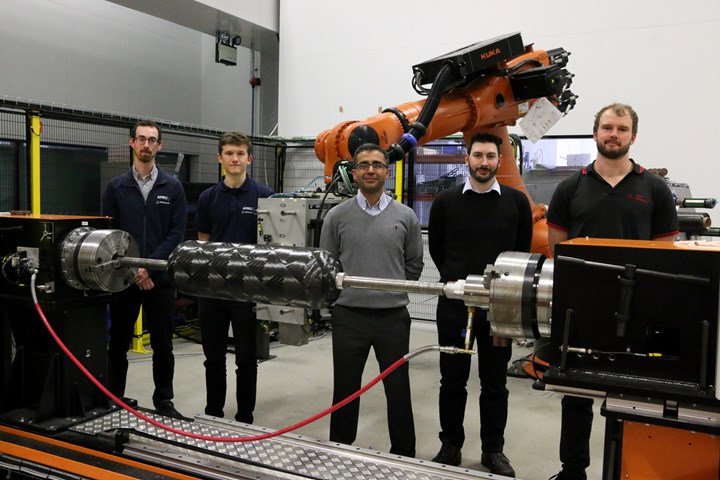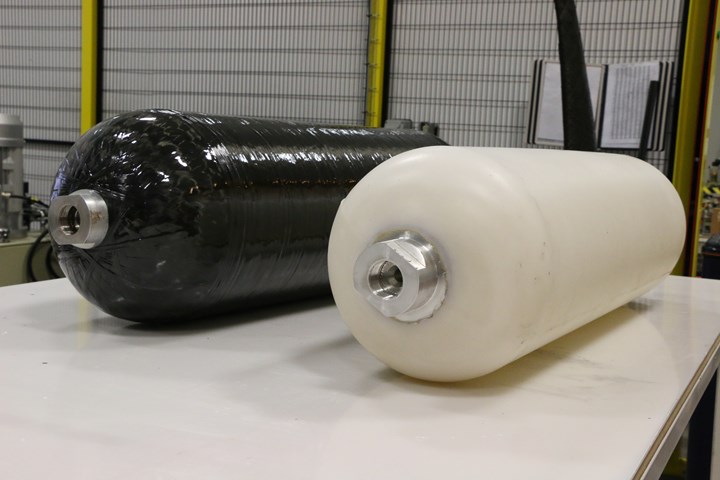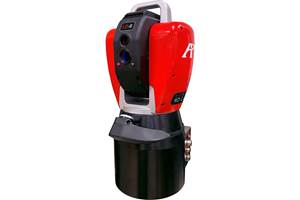AMRC, industrial partners develop Type IV hydrogen tank for long-haul vehicles
In the 12-month project, the University of Sheffield Advanced Manufacturing Research Centre (AMRC) has built prototype tanks and worked to build a secure U.K. supply chain.

Composites experts from the University of Sheffield Advanced Manufacturing Research Centre (AMRC, Catcliffe, U.K.) have announced the development of a composite hydrogen storage tank for use in the heavy transport sector, with the goal of helping decarbonization of road transport.
In a 12-month project, the AMRC worked with Crossfield Excalibur (Bury, U.K.), a specialist in tooling design for rotationally molded parts, and Elite Ground Support Services (Eaton Socon, U.K.), which provides rotational, extrusion and compression molds for the automotive sector.
Together, they designed, manufactured and tested a Type IV cylindrical hydrogen pressure vessel, made from filament-wound carbon fiber over a thermoplastic liner. The tank has been designed for use in the automotive sector and has the capacity to hold 40 liters of hydrogen at a 350-bar pressure, with the testing being performed in line with EU regulations.
The next steps are to continue optimizing the designs and the manufacturing process of the pressure vessels, develop testing capabilities further and to increase storage capacity.
The AMRC, part of the national network of High Value Manufacturing (HVM) Catapult research centers, is at the forefront of hydrogen tank prototyping, says Zeeshan Qureshi, lead research engineer at the AMRC Composite Centre.
He says, “Using state-of-the-art machines, cost-effective processes and working closely with our two chosen SMEs, we are on a mission to help accelerate the U.K. hydrogen storage supply chain and enable rapid production of hydrogen pressure vessels through automated design, manufacture and validation to meet net zero targets and to help push forward the decarbonization of road transportation nationwide. The project has also given us the chance to manufacture hydrogen pressure vessels using a filament winding machine, a process that has not been explored much within the U.K. It has been a fantastic opportunity to be part of such a project and we’re excited to push our research and testing further in the next project we have lined up.”

Stuart Dawson, chief engineer for hydrogen at the AMRC, says, “Heavy long-haul vehicles [HGVs] are one of the most challenging segments of the road transport sector to reduce emissions due to their long journey distances and heavy payload requirements. For the operational economics to stack up, HGVs need long range and fast refueling. The high weight of batteries would reduce the vehicle’s potential payload & range and would require long recharging times. So for heavy duty, long range transport applications, hydrogen fueled vehicles — whether they are powered via fuel cells or combustion — are the ideal solution. Conventional metallic hydrogen storage tanks are heavy and would reduce the vehicle's payload. What is needed for transport applications is safe, affordable and lightweight hydrogen storage tanks.
Dawson adds, “However, despite the high projected future demand for such tanks, there is virtually no U.K. manufacturing capability for composite pressure vessels. This project seeks to address this issue through the development of globally competitive methods of manufacture for lightweight, Type IV hydrogen storage tanks that could eventually be deployed into U.K. industry.”
As a direct result of the AMRC struggling to find suitable suppliers, the collaborative project says it has successfully created a secure U.K. supply chain for thermoplastic liners for the country’s OEMs.
Steve Davies, managing director of Crossfield Excalibur, says, “This project has given us the chance to deploy our experience in rotomolding product design and toolmaking over a span of 25 years. Along with the wider team, we have designed and developed a rotomolding insert, capable of molding and using a high flow polyamide polymer which withstands significant pressures. We have thoroughly enjoyed working with both teams at the AMRC and Elite to bring this project to life and look forward to assisting with the next phase of development.”
Kris Heard, managing director for Elite GSS, adds, “Not only are we pleased to be developing a new and innovative product for the U.K. market, but we’re also testing and stretching our manufacturing abilities further than ever before. As a project it also fits in with some of our key objectives; as a business, we strive to manufacture and distribute new and revolutionary technology whilst also having a key focus on the environment and reducing our carbon footprint.”
Investment into the creation of these pressure vessels follows the launch of the government’s net zero and hydrogen strategies and is aimed at supporting the U.K. to reach net zero emissions by 2050. The project was funded by the HVM Catapult.
Related Content
New Laser Technology in Non-contact Optical Dimensional Metrology
LADAR technology from API sets a new standard in non-contact optical dimensional metrology for manufacturing industries.
Read MoreSolidCAM Wants to Help Machine Shops Get into Additive Manufacturing
SolidCAM's partnership with Desktop Metal is aimed at making additive manufacturing more accessible to job shops and other manufacturers.
Read More4 Tips for Staying Profitable in the Face of Change
After more than 40 years in business, this shop has learned how to adapt to stay profitable.
Read MoreSandvik Coromant on Acquisitions: Solutions Entail More Than the Tool
A Q&A with global president Helen Blomqvist explores the cutting tool maker’s acquisition of CAM software companies and how this connects to, among other things, electric vehicles.
Read MoreRead Next
The Cut Scene: The Finer Details of Large-Format Machining
Small details and features can have an outsized impact on large parts, such as Barbco’s collapsible utility drill head.
Read More3 Mistakes That Cause CNC Programs to Fail
Despite enhancements to manufacturing technology, there are still issues today that can cause programs to fail. These failures can cause lost time, scrapped parts, damaged machines and even injured operators.
Read More
.jpg;width=70;height=70;mode=crop)










.png;maxWidth=300;quality=90)














